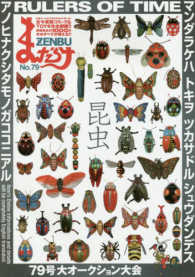- ホーム
- > 洋書
- > 英文書
- > Science / Mathematics
Full Description
Key Benefittextbook for the introductory college biology course for science majors. Every unit takes an approach to streamlining the material that best fits the needs of instructors, based on surveys, curriculum initiatives, reviews, discussions with hundreds of biology professors, careful analyses of course syllabi, and the report Vision and Change in Undergraduate Biology Education. The Second Edition builds on the Campbell hallmark standards of accuracy, clarity, and pedagogical innovation, going beyond this foundation to help students make connections visually across chapters, interpret real data from research, and synthesize their knowledge.The accompanying digital resources include new, mobile-friendly tools that help instructors teach challenging topics better than ever before; integrate the eText with videos and animations; and allow students to test, learn, and retest until they achieve mastery of the content. Key Topics: Introduction: Evolution and the Foundations of Biology, The Chemical Context of Life, Carbon and the Molecular Diversity of Life, A Tour of the Cell, Membrane Transport and Cell Signaling, An Introduction to Metabolism , Cellular Respiration and Fermentation, Photosynthesis, The Cell Cycle, Meiosis and Sexual Life Cycles, Mendel and the Gene Idea, The Chromosomal Basis of Inheritance, The Molecular Basis of Inheritance, Gene Expression: From Gene to Protein, Regulation of Gene Expression, Development, Stem Cells, and Cancer, Viruses, Genomes and Their Evolution, Descent with Modification, Phylogeny, The Evolution of Populations, , The Origin of Species, Broad Patterns of Evolution, Early Life and the Diversification of Prokaryotes, The Origin and Diversification of Eukaryotes, The Colonization of Land, The Rise of Animal Diversity, , Plant Structure and Growth, Resource Acquisition, Nutrition, and Transport in Vascular Plants, Reproduction and Domestication of Flowering Plants, Plant Responses to Internal and External Signals, The Internal Environment of Animals: Organization and Regulation, Animal Nutrition, Circulation and Gas Exchange, The Immune System, Reproduction and Development, Neurons, Synapses, and Signaling, Nervous and Sensory Systems, Motor Mechanisms and Behavior, Population Ecology and the Distribution of Organisms, Species Interactions , Ecosystems and Energy, Global Ecology and Conservation BiologyMarket: This book is a useful reference for anyone who wants to learn essential content, concepts, and scientific skills needed for introductory biology.
Contents
1. IntroductionUNIT 1: CHEMISTRY AND CELLS2. The Chemical Context of Life 3. Carbon and the Molecular Diversity of Life4. A Tour of the Cell5. Membrane Transport and Cell Signaling 6. An Introduction to Metabolism 7. Cellular Respiration and Fermentation8. Photosynthesis9. The Cell CycleUNIT 2: GENETICS10. Meiosis and Sexual Life Cycles11. Mendel and the Gene Idea12. The Chromosomal Basis of Inheritance13. The Molecular Basis of Inheritance14. Gene Expression: From Gene to Protein15. Regulation of Gene Expression16. Development, Stem Cells, and Cancer17. Viruses18. Genomes and Their EvolutionUNIT 3: EVOLUTION19. Descent with Modification20. Phylogeny21. The Evolution of Populations 22. The Origin of Species23. Broad Patterns of Evolution24. Early Life and the Diversification of Prokaryotes25. The Origin and Diversification of Eukaryotes26. The Colonization of Land27. The Rise of Animal Diversity UNIT 5: PLANT FORM AND FUNCTION28. Plant Structure and Growth29. Resource Acquisition, Nutrition, and Transport in Vascular Plants30. Reproduction and Domestication of Flowering Plants31. Plant Responses to Internal and External SignalsUNIT 6: ANIMAL FORM AND FUNCTION32. The Internal Environment of Animals: Organization and Regulation33. Animal Nutrition34. Circulation and Gas Exchange35. The Immune System36. Reproduction and Development37. Neurons, Synapses, and Signaling38. Nervous and Sensory Systems39. Motor Mechanisms and BehaviorUNIT 7: ECOLOGY40. Population Ecology and the Distribution of Organisms41. Species Interactions 42. Ecosystems and Energy43. Global Ecology and Conservation Biology







